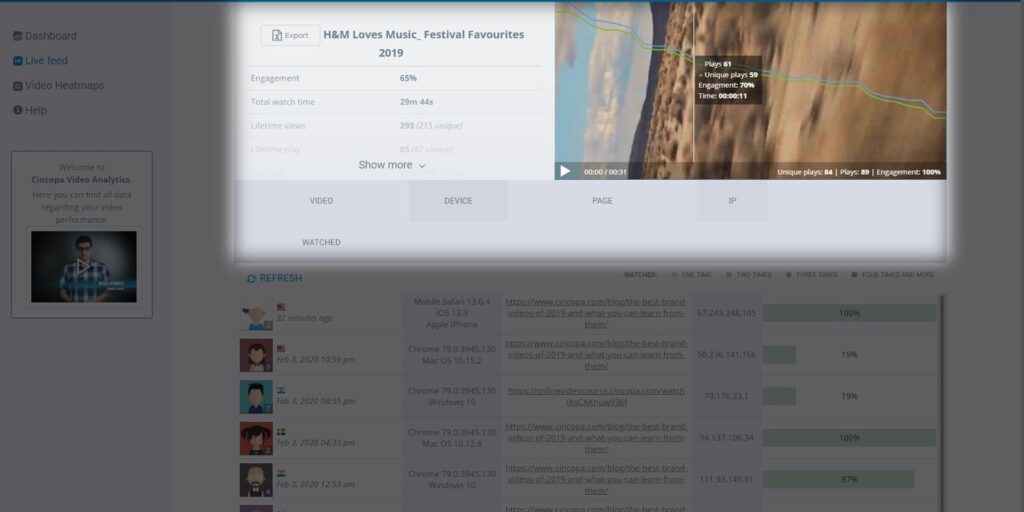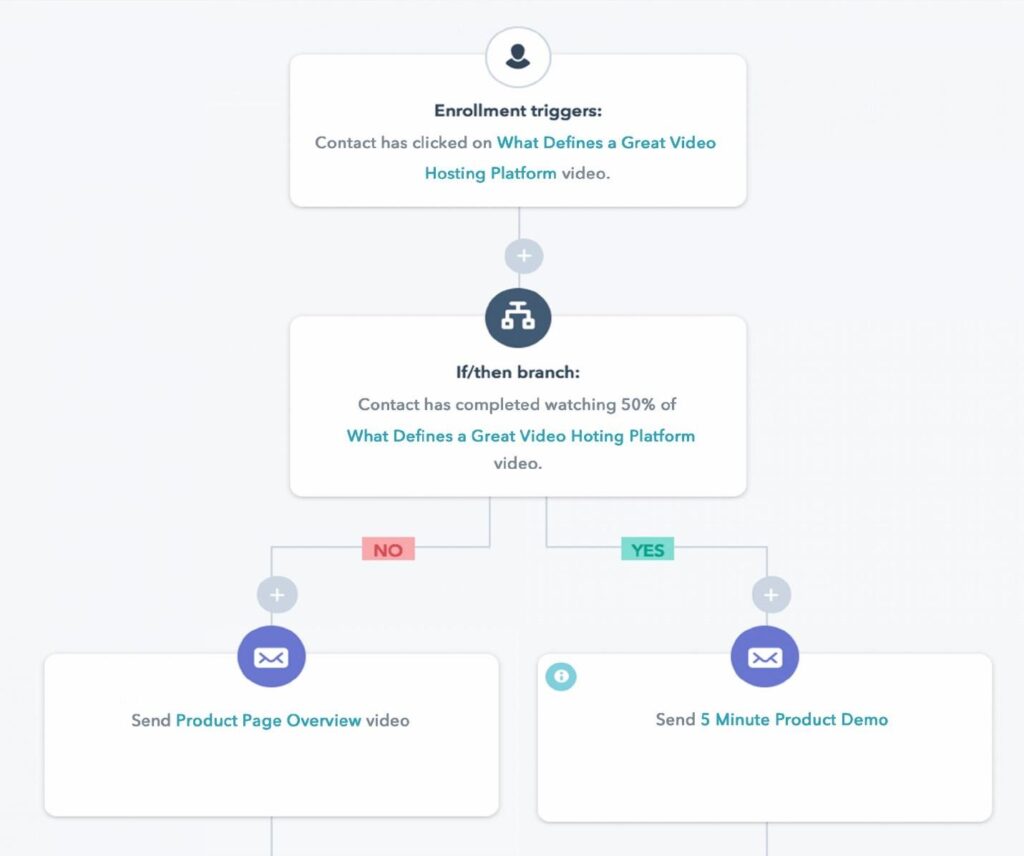Consider this: In less than 2 years, more than 80% of all consumer web traffic will be video.
If there was a Mount Rushmore of content, video would occupy all four spots.
In response, most businesses are prioritizing video marketing, investing resources, and upping their video game.
But, the question is, are businesses approaching video marketing correctly?
Video: A king without a crown
Picture this scenario: Your company, an eCommerce store, is about to launch a blitz email campaign leading up to Black Friday. You’ve made some amazing promos and got the best available marketing automation platform (e.g. EngageBay, HubSpot, and Marketo).
Your team has also created a series of engaging emails that will be sent to your vast contact base.
Let’s pause and examine the last part of that sentence.
How exactly did you come to accrue this contact base?
Sure, it probably consists of past customers. However, chances are that many of the names on that list have never actually purchased something from your site.
Often, contacts are those who clicked on your blog, visited your site a few times, or clicked on your Facebook ad.
Thanks to your marketing automation platform, these content interactions become the foundation of your contact base.
How each individual blog reader or email recipient engaged with your content dictates your future approach to them. For example, they may graduate from marketing-qualified to sales-qualified leads, or be sent hyper-specific content related to a niche product or service.
Video, the bona fide king of content, must be treated in the same way. Too often, however, it can’t be.
YouTube and Vimeo: Business go-tos for a reason?
Many, many businesses instinctively turn to free video platforms when the time comes to showcase their videos.
YouTube, and to a lesser extent Vimeo, have become internet staples, and with good reason. The former has unparalleled reach and is extremely easy to use.
But what was good for Bieber may not work as well for B2B companies, blockchain developers, and business intelligence firms.
It’s hard enough to get prospects to land on your site. By presenting them with a YouTube video, you’re making it that much easier for them to cut their visit short. All it takes is a click on the prominent YouTube icon showcased on the video player and they will bounce out of your site. Once down the YouTube rabbit hole (that we all enjoy falling through), the chance of them returning, or even remembering they were on your site, is low.
However, relying on YouTube presents you with additional, more glaring issues.
Beyond vanity metrics, such as like-to-dislike ratios and total views, there is really no way of gauging how your audience engaged with your YouTube video; let alone how individual viewers interacted with it.
Having video act as an online billboard simply does not cut it for companies that value high-quality lead generation.
A new approach is therefore in order, one that enables businesses to approach video marketing far more strategically.
The power of other video hosting platforms
To fill this critical business need, companies and marketing departments have begun relying on video management and hosting platforms.
There are a number of high-quality video hosting platforms that have become familiar faces within the worlds of marketing and tech. All indicators point to these platforms gaining widespread recognition in the near future.
Highly intuitive and easy to use, these platforms enable users to create, upload, and showcase videos on their website in a few clicks.
Not wanting to miss out on the benefits of cultivating a following on YouTube, savvy marketers often employ the following dual approach.
Videos presented on the company website and which are included in email campaigns are hosted exclusively on a video hosting platform. At the same time, promotional videos are uploaded to the company’s YouTube channel.
The irony is that while the latter is often created specifically for YouTube, it’s impossible to see exactly who watched AND how they watched.
Core video analytics features and tools
Good hosting platforms solve the problem of visitors bouncing out of your site when engaging with a video. Additionally, with customization capabilities and dynamic features, they help transform your site into an immersive video destination.
However, the crown jewel of video hosts’ offerings are their analytical features and tools.
Good video hosting platforms truly introduce you to each of your video viewers.
Who watched a specific video, how much of it he or she viewed, the type of device that was used to watch the video, and the viewer’s geographic location; all this data is easily discerned thanks to a host’s advanced APIs.
Features such as video-heatmaps give a clear picture of the performance of every video. Platforms can also present you with a detailed graph showing the exact moment each viewer stopped viewing (i.e. ‘the drop-off point’).
If you see a major drop-off at a certain point in a video, you can then optimize, by either cutting the video short or extending the themes that viewers enjoyed (i.e. the content before the drop-off).

A video heatmap as displayed by Cincopa
Remember the eCommerce Black Friday email campaign scenario from earlier? This time, imagine it with video.
By integrating with your marketing automation platform, your contacts’ interaction with specific videos can be fed into your HubSpot account’s CRM. This allows you to build workflows with video engagement set as enrollment triggers (e.g. ‘Include contacts who watched video X beyond the 20-second mark ‘) or as a condition for further activity (e.g. ‘If contact watched video Y beyond the 45-second mark, he or she should be contacted by sales. If he or she fell short of the 45-second mark, send him or her an email).

An example of HubSpot workflow that uses video engagement as an enrollment trigger and within an If/then branch
With video being the form of content your site visitors are most likely to engage with, it would be a waste to not incorporate video while scoring leads.
On HubSpot, for example, you can attribute positive points to contacts who fulfil desired video engagement, e.g. ‘the contact was awarded 5 points for completing 2 videos’.
Conversely, you can ‘award’ negative points to contacts exhibiting lackluster video interaction. E.g. ‘The contact was given -5 points for watching less than 20 seconds of video X.
Video analytics make all of this possible.

On HubSpot, you can define positive and negative attributes to contacts’ interaction with videos
Big takeaways
Heavy is the head that wears the crown.
With videos as the unequivocal kings of content, we expect a lot from them. But relying on conventional platforms and solutions strip videos of the ability to deliver their true ROI potential.
Businesses looking to approach video marketing strategically need to know as much as possible about who, where, when, and how their videos are being watched. Advanced video hosting and management platforms offer advanced analytical features and tools that will show you exactly how your videos are being interacted with. Through powerful integrations, this data can be synched with your marketing automation platform and leveraged toward further dynamic lead qualification and nurturing.
- About the author
Yoni Yampolsky, Cincopa Marketing Manager
Yoni Yampolsky is a marketing manager at Cincopa. A powerful multimedia management and hosting solution, Cincopa helps businesses untap their videos’ true conversion potential.

